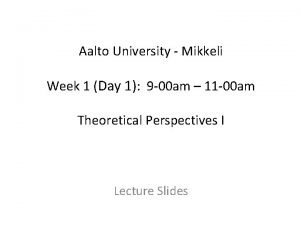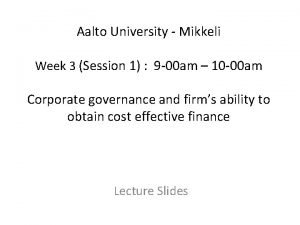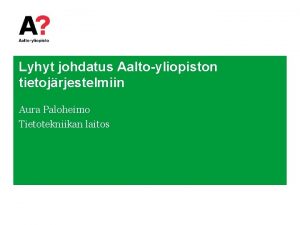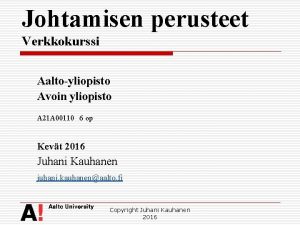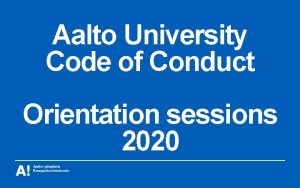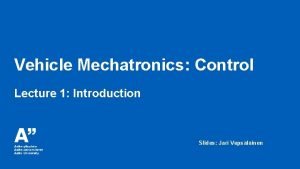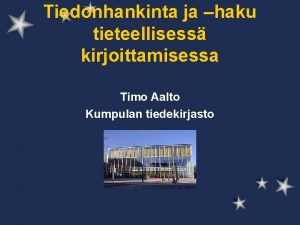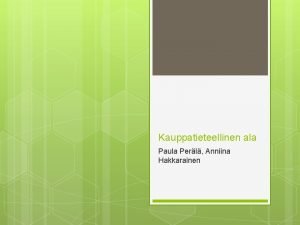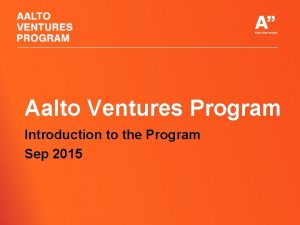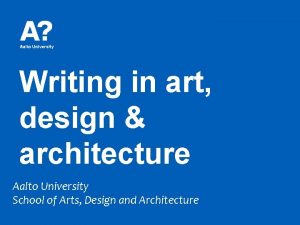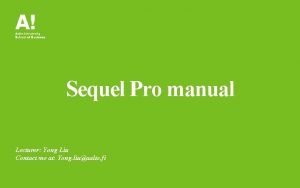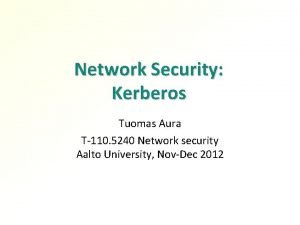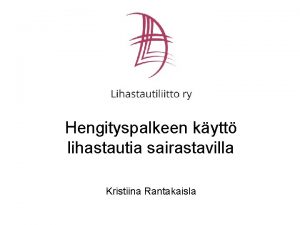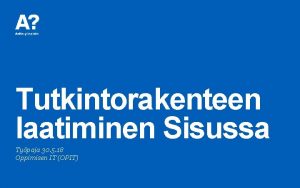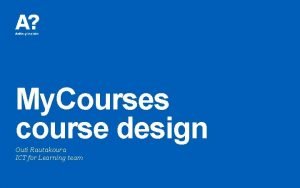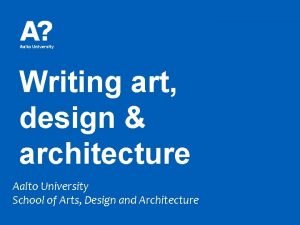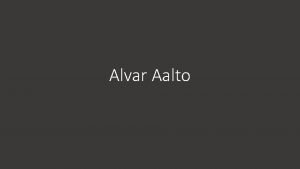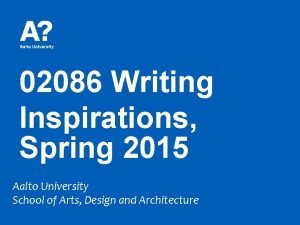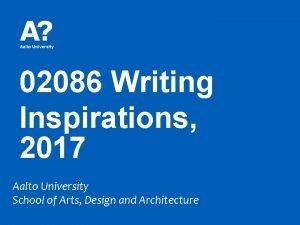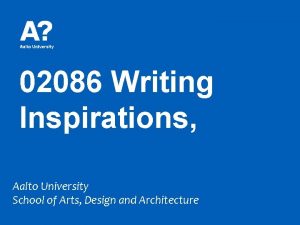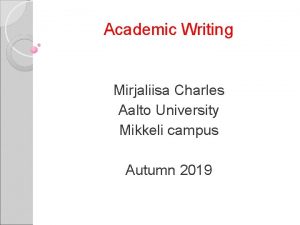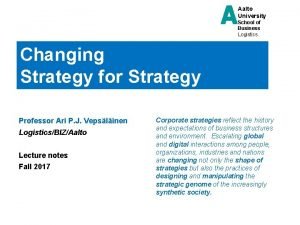Writing in art design architecture Aalto University School























- Slides: 23

Writing in art, design & architecture Aalto University School of Arts, Design and Architecture

Session 1 • Intro to the course • Getting acquainted • Intro to Mycourses (if needed? ) • Intro to Learner Blogging • First Learner Blog in class • Instructions for next lesson: an online class 1/13/15 2

Writing Inspirations Teacher: Will Sillitoe, Email: will. sillitoe@aalto. fi 1/13/15 3

Course Goals Upon the completion of this course, students will be able to • write about concepts related to art, design and architecture • demonstrate the stages of writing from inspiration to revision and final work • construct sentences and paragraphs that are cohesive and easy to read • write both formal and informal texts 1/13/15 4

Course Content (in class) • Elements of both creative and academic or professional writing. • Paragraph and essay structure as well as cohesion and coherence. • Collaboration with peers through brainstorming, sharing ideas, responding to each other’s writing, and giving feedback. 1/13/15 5

Course Content (at home) • Four (longer) writing assignments • 4 shorter Learner activities • Some exercises 1/13/15 6

Assessment methods 1/2 • Regular attendance required • (max two absences; 3 rd > - 5% off the grade; more than 3> fail!!) • No compensation for missed classes. • No compensation for missed deadlines. (Mycourses missed deadlines. ) • Work submitted late will NOT be accepted or commented on. 1/13/15 7

Assessment methods 2/2 Completion of four writing assignments (from planning stage to the final version) 1) Exhibition writing 5% (graded) = 5% 2) Artist Statement 5% +15% (graded) = 20% 3) Job Application 5% + 15% (graded) = 20% 4) Visual Analysis 5% + 20% (graded) = 25% • Completion of 4 learner activities / 150 -200 words each 20% • Active in-class contribution & participation 10% • = total of 100% 1/13/15 8

Study Materials Provided by the teacher (and you!) 1/13/15 9

Any questions? Still interested in the course? 1/13/15 10

Getting Acquainted Write a short (150 – 200 words) introduction to yourself including the following: who are you? , what do you study, which year of studies? , how do you like your studies here? , how do you feel about being here today/ taking this English course? (be honest), how do you see your own writing skills in English? other comments? 1/13/15 11

Getting Acquainted Swap your paper with your neighbor. Read your neighbor’s intro to him/herself. Introduce your neighbour to the rest of the class. Help the rest of us remember your neighbour’s name! 1/13/15 12

Learner task 1: Go to mycourses. aalto. fi Session 1: Writing Activities 1 1/13/15 13

Learner Blog.

Why use short writing activities on this course? Write and express yourself freely in English. Informal expression of ideas & thoughts. No teacher intervention/ comments on your language, only some comments on the content of your posts. 4 entries in total with each entry of min. 150 – 200 words. Minimum of 2 replies to others’ posts. Must be submitted by the deadline. No work submitted after the deadline will be accepted! 1/13/15 15

Why use Writing Activities? • Records progress of your learning • Helps you think deeply about the process of learning • Strategies to get around those difficulties • Your evaluation of your own performance • Communicates your thinking process: how and why you did what you did, and what you now think about what you did • Helps get to know the other students better and how they feel/write about the same issues EVERYONE CAN READ YOUR WORK! 1/13/15 16

Writing Activity 1: Write a short introduction to yourself and your goals and expectations for this course (150 -200 words) in ’email format’ to your teacher. Submit this in Mycourses – Session 1, Writing Activity 1 by Friday. 1. Your Background • as a (TAIK) Student • as a student of English 1. Your goals and expectations for the course • What are the skills you want to improve during this course? • Ideas, wishes? 1/13/15 17

No Session two! • Please go through Session 2 slides in Moodle and acquaint yourself with the online sources mentioned. • Write your Writing Activity 2 (150 - 200 words) on what you learned or found useful. You can also discuss an online tool you use that was not mentioned in my slides. • Submit your Writing Activity 2 before our next lesson (23: 55). 1/13/15 18

Intro to Exhibition writing (for next lesson) • The students choose exhibitions to visit this week • Opening hours/ cost: check online • Each student will work on a different aspect of the exhibition (see the following list; other aspects? ). • Brainstorm your own topic. • Visit the exhibition, make notes while there. 1/13/15 19

Intro to Exhibition writing • Read any texts on the walls. • If a brochure is available, take it and read it to get more out of the exhibition. Take notes on the comments, too. • Take notes of even all of your own responses to individual works. • Put down everything you think is worth saying, and don’t limit yourself. You will revise your writing only later. • Express your opinions by calling attention to details (Descriptive words). • Bring your draft (150 -200 words, full sentences) to class. 1/13/15 20

Intro to Exhibition writing • Read any texts on the walls. • If a brochure is available, take it and read it to get more out of the exhibition. Take notes on the comments, too. • Take notes of even all of your own responses to individual works. • Put down everything you think is worth saying, and don’t limit yourself. You will revise your writing only later. • Express your opinions by calling attention to details (Descriptive words). • Bring your draft (150 -200 words, full sentences) to next class. 1/13/15 21

Exhibition writing A description of a layout () An observation of the viewers at the exhibition () An interview of another exhibition visitor () A description of the content () Other inspirations (creative, reflective, analytical) () Putting the subject in its art-historical context () A comparison to other exhibitions () Bringing out the negative side of the exhibition () Personal feelings, inspirations… () Relevance to your own field () 1/13/15 22

Exhibition writing • Then the pieces will be discussed and edited by the group • Useful for: appreciation of styles, practice in doing different alternatives, contribution of feedback, experience of editing 1/13/15 23
 Aalto university school of engineering
Aalto university school of engineering Aalto university mikkeli
Aalto university mikkeli Aalto university mikkeli
Aalto university mikkeli Aalto eduroam
Aalto eduroam Aalto yliopisto johtaminen
Aalto yliopisto johtaminen Aalto eduroam
Aalto eduroam Aalto code of conduct
Aalto code of conduct Kari tammi aalto
Kari tammi aalto Mot sanakirja aalto
Mot sanakirja aalto Aalto noppa
Aalto noppa Aalto yritysjuridiikka
Aalto yritysjuridiikka Kauppakorkeakoulu pisterajat
Kauppakorkeakoulu pisterajat Aalto ventures program
Aalto ventures program About myself
About myself Aalto
Aalto Sequel
Sequel Key windows
Key windows Into aalto mikkeli
Into aalto mikkeli Funet filesender aalto
Funet filesender aalto Keuhkon osat
Keuhkon osat Sisu aalto hops
Sisu aalto hops My courses aalto
My courses aalto Secclo aalto
Secclo aalto Sphere of influence
Sphere of influence

